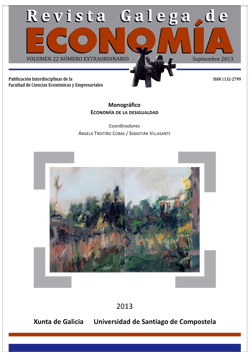El patrón desigual de crecimiento europeo: un análisis semiparamétrico a nivel regional
Contenido principal del artículo
Resumen
Palabras clave:
Detalles del artículo
Referencias
AHLUWALIA, M.S.; CARTER, N.G.; CHEN, H.B. (1979): “Growth and Poverty in Developing Countries”, Journal of Development Economics, 6, pp. 299-341.
ALESINA, A.; RODRIK, D. (1994): “Distributive Politics and Economics Growth”, Quarterly Journal of Economics, 109 (2), pp. 465-490.
ALVAREDO, F.; SÁEZ, E. (2006): Income and Wealth Concentration in Spain in a Historical and Fiscal Perspective. (CEPR Discussion Paper Series, 5836). London: The Centre for Economic Policy Research. .
ANAND, S.; KANBUR, S.M.R. (1993a): “The Kuznets Process and the Inequality-Development Relationship”, Journal of Development Economics, 40, pp. 25-52.
ANAND, S; KANBUR, S.M.R. (1993b): “Inequality and Development. A Critique”, Journal of Development Economics, 41, pp. 19-43.
ANSELIN, L.; FLORAX, R.J.G.M.; REY, S.J. [ed.] (2004): Advances in Spatial Econometrics. Methodology, Tools and Applications. Berlin: Springer.
BANERJEE, A.V.; DUFLO, E. (2003): “Inequality and Growth: What Can the Data Say?”, Journal of Economic Growth, 8, pp. 267-299.
BARRO, R. (2000): “Inequality and Growth in a Panel of Countries”, Journal of Economic Growth, 5, pp. 5-32.
BORUGUIGNON, F.; MORRISON, C. (1998): “Inequality and Development: The Role of Dualism”, Journal of Development Economics, 57, pp. 233-257.
CHAMBERS, D. (2007): “Trading Places: Does Past Growth Impact Inequality?”, Journal of Development Economics, 82, pp. 257-266.
COWELL, F.A. (2000): Measuring Inequality. 3ª ed. (London School of Economics Series). London: Oxford University Press. <http://piketty.pse.ens.fr/files/CowellMeasuringInequality2000.pdf>.
DEININGER, K.; SQUIRE, L. (1998): “New Ways of Looking at Old Issues: Inequality and Growth”, Journal of Development Economics, 57, pp. 259-287.
EZCURRA, R. (2007): “Is Income Inequality Harmful for Regional Growth? Evidence from the European Union”, Urban Studies, 44, pp. 1953-1971.
FALLAH, B.N.; PARTRIDGE, M. (2007): “The Elusive Inequality-Economic Growth Relationship: Are there Differences between Cities and the Countryside?”, American Regional Science, 41, pp. 375-400.
FRANK, M.W. (2009): “Inequality and Growth in the United States: Evidence from a New State-Level Panel of Income Inequality Measures”, Economic Inquiry, 47 (1), pp. 55-68.
GALBRAITH, J.K.; BERNER, M. (2004[2001]): Desigualdad e cambio industrial. Una perspectiva global. Madrid: Akal.
GALOR, O. (2000): “Income Distribution and the Process of Development”, European Economic Review, 44, pp. 706-712.
GALOR, O.; MOAV, O. (2004): “From Physical to Human Capital Accumulation; Inequality and the Process of Development”, Review of Economics Studies, 71, pp. 1001-1026.
GORDON, R.J.; DEW-BECKER, I. (2008): Controversies about the Rise in American Inequality: A Survey. (NBER Working Paper Series, 13982). Cambridge, MA: The National Bureau of Economic Research (NBER). .
HUANG, H.C.R. (2004): “A Flexible Nonlinear Inference to the Kuznets Hypothesis”, Economics Letters, 84, pp. 289-296.
KUZNETS, S. (1955): “Economic Growth and Income Inequality”, American Economic Review, 45 (1), pp. 1-28.
LIN, S.C.; HUANG, H.C.R.; WENG, H.W. (2006): “A Semiparametric Partially Linear Investigation of the Kuznets’ Hypothesis”, Journal of Comparative Economics, 34, pp. 634-647.
LIST, J.A.; GALLET, C.A. (1999): “The Kuznets Curve: What Happens after the U-Inverted?”, Review of Development Economics, 3 (2), pp. 200-206.
MERCADER-PRATS, M.; LEVY, H. (2004): The Role of Tax and Transfers in Reducing Personal Income Inequality in Europe’s Regions: Evidence from EUROMOD. (EUROMOD Working Paper Series EM9/04). Colchester: University of Essex, Institute for Social & Economic Research (ISER).
MOLERO, R.; VAYÁ, E. (2000): Técnicas econométricas para el tratamiento de datos espaciales: la econometría espacial. Barcelona: Universitat de Barcelona.
MUSHINSKI, D. (2001): “Using Non-Parametrics to Inform Parametric Tests of Kuznets’ Hypothesis”, Applied Economics Letters, 8 (2), pp. 77-79.
PANIZZA, U. (2002): “Income Inequality and Economic Growth: Evidence from American Data”, Journal of Economic Growth, 7, pp. 25-41.
PARTRIDGE, M.D. (1997): “Is Inequality Harmful for Growth? Comment”, American Economic Review, 87, pp. 1019-1032.
PARTRIDGE, M.D. (2005): “Does Income Distribution Affect U.S. State Economic Growth”, Journal of Regional Science, 45, pp. 363-394.
PERACCHI, F. (2002): “The European Community Household Panel: A Review”, Empirical Economics, 27, pp. 63-90.
PERSSON, T.; TABELLINI, G. (1994): “Is Inequality Harmful for Growth?”, American Economic Review, 84, pp. 600-621.
PERUGINI, C.; MARTINO, G. (2008): “Income Inequality within European Regions. Determinants and Effects on Growth”, Review of Income and Wealth, 54 (3), pp. 373-406.
RAY, D. (2002): Economía del desarrollo. Barcelona: Bosch.
RODRÍGUEZ, D.; VENCE, X. (2007): “Is it the End of the U-Inverted Relationship between Income and Inequality. An Appraisal from European Regions”, ECINEQ 2007. Berlin: The Society for the Study of Economic Inequality (ECINEQ).
RODRÍGUEZ-POSE, A.; TSELIOS, V. (2009a): “Education and Income Inequality in the Regions of the European Union”, Journal of Regional Science, 49 (3), pp. 411-437.
RODRÍGUEZ-POSE, A.; TSELIOS, V. (2009b): “Inequalities in Income and Education and Regional Economic Growth in Western Europe”, Annals of Regional Science, 44 (2), pp. 349-375.
RUPPERT, D.; WAND, M.P.; CARROLL, R.J. (2009): Semiparametric Regression During 2003-2007. <http://cran.r-project.org>.
SAITH, A. (1983): “Development and Distribution. A Critique of the Cross-Country U-Hypothesis”, Journal of Development Economics, 13, pp. 367-382.
TROITIÑO, A. (2005): “Inequality of Disposable Income within and between the UE (15) Countries. Levels, Sensitivity and Recent Evolution Using the ECHP (1994-01)”, ECINEQ 2005. Palma de Mallorca: The Society for the Study of Economic Inequality (ECINEQ).
VENCE, X. (2005): O fracaso neoliberal na Galiza. Vigo: A Nosa Terra. WAND, M.P. et al. (2005): SemiPar 1.0. R package. <http://cran.r-project.org>.
ZWEIMÜLLER, J. (2000): Inequality, Redistribution and Economic Growth. (Working Paper, 31). Zurich: University of Zurich, Institute of Empirical Research in Economics.






